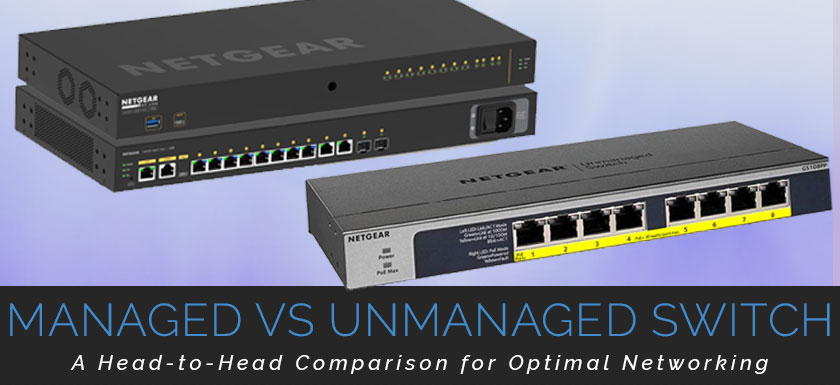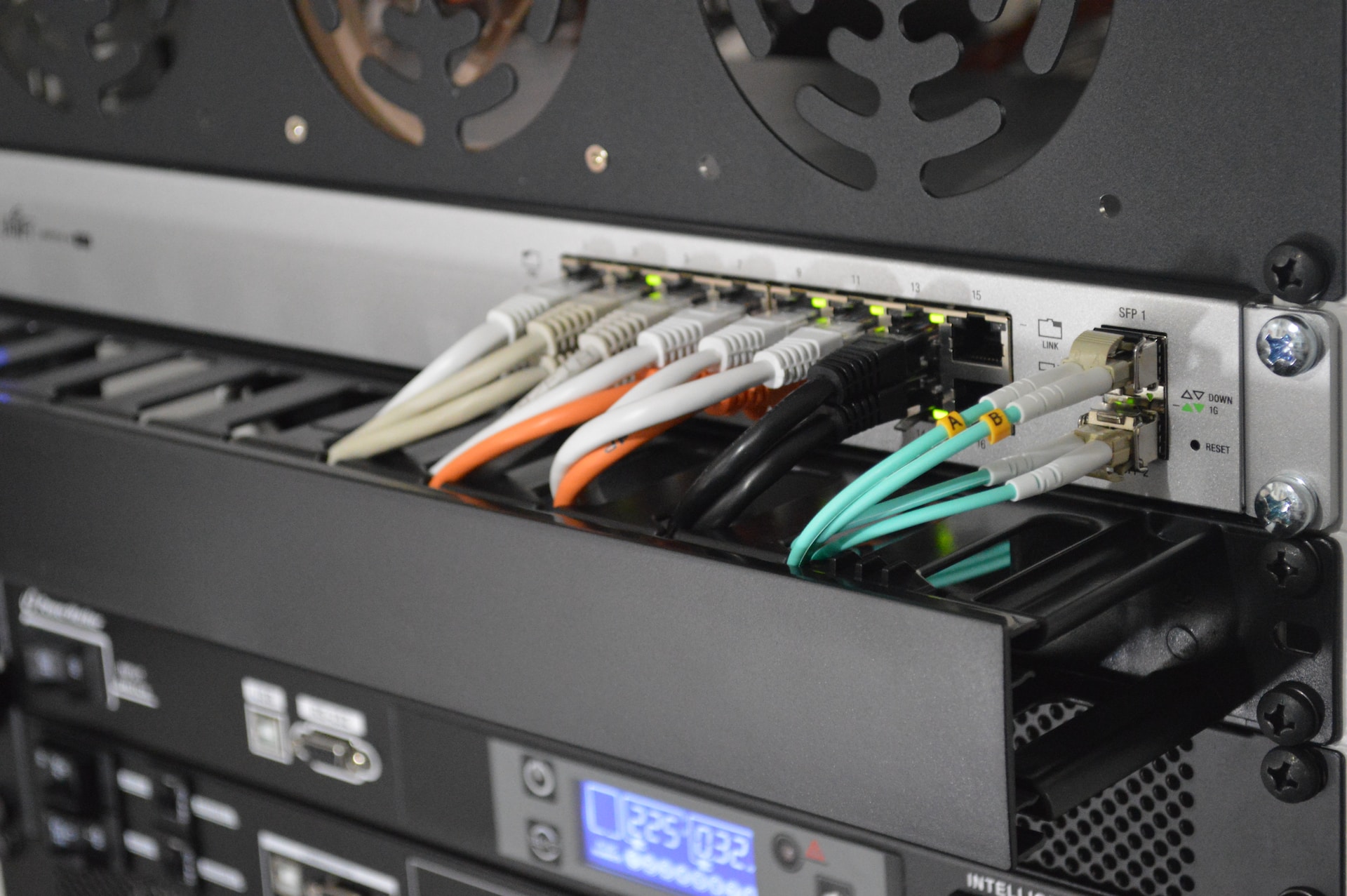
Imagine the world of networking without switches – it’s like trying to navigate a complex maze without a map. In today’s tech-driven universe, network switches are the unsung heroes of modern IT infrastructure. They are the traffic cops of the digital world, ensuring that data flows smoothly from one device to another. But here’s the catch – not all switches are created equal.
The type of switch you use is important for your network’s performance. Think of your network as a busy city, with data packets moving around like cars on a highway. The switch acts as the traffic management system, ensuring that data packets reach their intended destinations efficiently. Your choice of switch can either enhance or hinder your network’s performance.
In this blog post, we’ll delve deep into the heart of networking to explore the two main categories of switches: managed and unmanaged switches.
We’ll cover their key differences, weigh their pros and cons, and equip you with the knowledge to make the best decision for your unique network needs. So, whether you’re running a small home network or overseeing a sprawling enterprise infrastructure, you’ll be armed with the insights needed to make an informed choice that will keep your network humming along smoothly.
What Are Network Switches?

If networks were a movie, switches would be the backstage crew making sure everything runs smoothly, even if they’re not in the spotlight.
Here’s a quick rundown of the key types of network switches:
Managed Switches
Think of these as the control freaks of the switch world (in a good way!). Managed switches give you the power to fine-tune your network’s performance. They allow network professionals like you to monitor traffic, segment it into virtual LANs (VLANs), prioritize certain data for faster delivery (Quality of Service or QoS), and beef up security with advanced features like access control lists. In a nutshell, managed switches are your go-to choice when you need to wield some serious network wizardry.
Unmanaged Switches
If you prefer a “set it and forget it” approach, unmanaged switches are your best option. They’re like the plug-and-play of networking. These switches are super user-friendly and require minimal setup. They’re perfect for smaller networks or situations where simplicity reigns supreme. Just plug in your devices, and voila! Data flows freely without you breaking a sweat.
In essence, understanding the world of network switches is like having the blueprint to design your network’s infrastructure.
In the next sections, we’ll peel back the layers of managed and unmanaged switches to help you decide which one’s the right tool for your networking job. So, grab your network toolkit and let’s get tinkering!
The Managed Switch
What are managed switches?
Managed switches are the network professional’s best friend when it comes to flexibility and control. These switches go beyond the basics of simply forwarding data packets; they give you the keys to the kingdom. With a managed switch, you have the power to monitor, configure, and optimize your network to meet your precise requirements.
Benefits of Using Managed Switches
Network Monitoring and Control: Ever wished you could see what’s happening in your network in real-time? Managed switches make that dream a reality. They come equipped with a dashboard that provides you with insights into your network’s traffic patterns, device activity, and potential bottlenecks. This real-time visibility is invaluable for troubleshooting issues and optimizing performance.
VLAN Support: Virtual LANs (VLANs) are like digital dividers that let you segment your network into smaller, isolated groups. Managed switches excel at creating and managing VLANs, allowing you to keep sensitive data separate from public traffic or streamline communication within specific departments. It’s like having different conference rooms at a bustling party, each with its own guest list and conversation.
Quality of Service (QoS) Management: Managed switches enable you to prioritize certain types of data traffic. For instance, you can give video conferencing or voice-over-IP (VoIP) calls top priority, ensuring smooth communication even when your network is busy with other data transfers. It’s like having a VIP lane on a crowded highway for your most important data.
Enhanced Security Features: Security is paramount in today’s digital landscape, and managed switches have your back. They offer advanced security features like access control lists (ACLs) that allow you to define who can access specific parts of your network. It’s like having a bouncer at the door who checks IDs and ensures only authorized users get in.
Browse Managed Network SwitchesThe Unmanaged Switch
What are Unmanaged Switches?
Unmanaged switches are the ‘plug-and-play’ champs of the networking world. They do the essential job of connecting devices in a network without the bells and whistles of their managed counterparts. You just plug in your devices, and they work their magic, silently and efficiently.
Benefits of Using Unmanaged Switches
Simplicity and Ease of Use: Unmanaged switches are a breath of fresh air when you’re after sheer simplicity. They require minimal setup or configuration, making them perfect for those who aren’t networking wizards. It’s like using a basic, reliable toaster – you pop in the bread, press a button, and it does its job without any fuss.
Small-Scale or Non-Critical Networks: Unmanaged switches are like the comfy flip-flops of networking. They’re ideal for smaller networks, home setups, or scenarios where you don’t need advanced features. For instance, if you’re setting up a home network to connect your smart devices, gaming consoles, and streaming devices, an unmanaged switch can keep everything connected seamlessly without overwhelming you with options.
In essence, unmanaged switches are the ‘set it and forget it’ solution. They quietly do their job, ensuring your devices can communicate with each other without demanding your constant attention. So, whether you’re keeping things simple, have a small network, or just want to avoid the complexity of managed switches, unmanaged switches have your back.
Browse Unmanaged Network SwitchesManaged vs Unmanaged Switch: A Head-to-Head Comparison
We’ll break down the essential factors that matter to network professionals like you and help you decide which one’s the hero your network deserves.
Performance Comparison
Throughput and Latency Considerations: Managed switches typically come out on top in this category. They’re like the sports cars of networking, capable of handling heavy traffic and optimizing data flow. Managed switches often have higher throughput and lower latency, ensuring your data zooms through your network like a bullet train.
Scalability and Expansion Options: Here’s where managed switches flex their muscles. They’re like Lego sets for network pros, allowing you to expand and customize your network with ease. Want to add more devices? No problem. Need to create new VLANs? Piece of cake. Managed switches offer the flexibility to adapt your network as it grows.
Configuration and Management
Differences in Setup and Administration: Unmanaged switches take the prize for simplicity here. They’re like the “Easy” mode in a video game – plug them in, and they work. Managed switches, on the other hand, require a bit more setup and configuration, but it’s a trade-off for the control they provide.
User Interface and Learning Curve: Unmanaged switches win the ‘user-friendly’ award. Their interface is often intuitive and straightforward, making them accessible to even those with limited networking experience. Managed switches, with their advanced features, might have a steeper learning curve, but the payoff is worth it for those who want to master the art of network orchestration.
Security
Vulnerabilities and Mitigation Strategies: Managed switches are like the vigilant security guards of your network. They offer advanced security features like access control lists (ACLs) and port security. Unmanaged switches, while simple, lack these robust security features, leaving your network more vulnerable to unauthorized access.
Cost Analysis
Upfront Costs vs. Long-Term Savings: Unmanaged switches are budget-friendly upfront. They’re like the thrift store find that gets the job done without breaking the bank. However, managed switches, while pricier initially, can lead to long-term savings by reducing downtime, improving efficiency, and enhancing security.
So, as you can see, it’s not a one-size-fits-all situation. The choice depends on your network’s needs, your expertise, and your budget.
Managed switches offer power and customization, while unmanaged switches keep things simple and cost-effective. Ultimately, it’s all about finding the perfect fit for your network’s unique demands.
Use Cases for Managed Switches

Managed switches aren’t just fancy gadgets for tech enthusiasts; they’re vital tools for some of the most demanding networking scenarios out there. Here are three real-world situations where managed switches are absolute game-changers:
Enterprise-Level Networks
Picture a massive skyscraper, buzzing with offices, each filled with employees relying on a seamless network to do their jobs. That’s where managed switches come into their own. In the world of enterprise networking, reliability, performance, and control are non-negotiable. Managed switches allow network administrators to monitor traffic, allocate resources efficiently, and ensure that the network is always up and running. When you’ve got hundreds or even thousands of devices relying on your network, managed switches are your trusted guardians.
Data Centers
Data centers are like the Fort Knox of the digital world, housing invaluable information and services. When you’re dealing with that level of data, downtime is not an option. Managed switches provide the precision and flexibility needed to manage the colossal traffic loads in data centers. They can prioritize critical traffic, create redundancies for failover protection, and offer detailed analytics to optimize performance. In a data center, managed switches are like the conductor of a symphony, ensuring every note (or byte) is in perfect harmony.
High-Security Environments
Imagine a top-secret government facility or a bank’s data center – places where security isn’t just a priority; it’s a matter of national importance. Managed switches offer advanced security features like access control lists (ACLs) and port security to fortify defenses against unauthorized access. They can also segment traffic to keep sensitive data isolated from the rest of the network, making them the go-to choice for high-security environments.
In these scenarios, managed switches aren’t just a luxury; they’re a necessity. They provide the control, performance, and security required to keep critical operations running smoothly.
Use Cases for Unmanaged Switches

Alright, folks, we’ve covered the glitzy world of managed switches, but don’t underestimate the simplicity and charm of unmanaged switches. Here are three real-life scenarios where unmanaged switches step into the spotlight:
Small Businesses
Small businesses are often juggling a hundred things at once, and complicated network setups can feel like an unnecessary headache. Unmanaged switches are the unsung heroes here, offering a straightforward solution that keeps things running smoothly. Plug in your computers, printers, and other devices, and you’re good to go. No need for a dedicated IT guru to configure things – simplicity is the name of the game.
Home Networks
Let’s face it – not all of us are networking wizards, and we don’t need to be. Unmanaged switches are like the “set it and forget it” appliances of the networking world. They’re perfect for connecting all your gadgets at home, from smart TVs and gaming consoles to laptops and streaming devices. No need to dive into complex settings; just plug in and enjoy a seamless connection.
Temporary Setups
Imagine you’re setting up a temporary network for an event, like a conference or a pop-up shop. You need something that works quickly and reliably without a lot of fuss. Enter unmanaged switches. They’re like the trusty folding table you set up for a weekend garage sale – simple, efficient, and no need for a user manual.
In these situations, unmanaged switches are like your tech-savvy buddy who swoops in to save the day. They provide hassle-free connectivity without overwhelming you with options. So, if you’re running a small business, keeping your home network humming, or setting up a quick and easy temporary network, unmanaged switches are the unsung heroes you can count on.
Making the Right Choice
Below are some factors to consider when deciding between managed vs. unmanaged switches:
Network Size and Complexity: Think about the size of your network and how complex it is. Are you managing a sprawling corporate infrastructure with hundreds of devices, or is it a cozy home network with a handful of gadgets? Managed switches are like a Swiss army knife for big and intricate setups, while unmanaged switches shine in smaller, straightforward networks.
Budget Constraints: Ah, the budget – the ever-present elephant in the room. Managed switches might have a higher initial cost, but remember that they often lead to long-term savings through enhanced efficiency and security. Unmanaged switches are budget-friendly upfront but might lack some advanced features.
Future Scalability: Think about where your network is headed. Are you planning to expand it in the future? Managed switches are scalable, ready for your growth. Unmanaged switches might suffice for now but could limit your options down the road.
Step-by-Step Guide to Choosing the Most Suitable Switch
Take Stock of Your Network: Begin by understanding your network’s current state. List all the devices you have and how they connect. Determine if your network is growing or likely to stay the same size.
Assess Your Budget: Be clear about your budget constraints. Factor in not only the switch’s purchase price but also long-term operational costs.
Evaluate Your Network’s Complexity: Consider the level of control and management you need. Are there specific features, like VLANs or QoS, that are essential for your operations? Managed switches offer these capabilities, but if your network is simple, an unmanaged switch might suffice.
Think About Security: Security is paramount. If your network handles sensitive data or needs robust access control, managed switches are the way to go.
Plan for the Future: If your network is likely to grow, think long-term. Managed switches provide scalability and future-proofing.
Consult with Experts: Don’t hesitate to seek advice from networking professionals or colleagues who have experience with similar setups.
Test the Waters: If you’re unsure, consider starting with a few unmanaged switches and then transitioning to managed switches as your network grows and your needs become clearer.
Key Takeaways
- Managed switches offer advanced control, monitoring, and security features, making them ideal for larger, complex networks, data centers, and high security environments.
- Unmanaged switches provide simplicity and ease of use, making them suitable for small businesses, home networks, and temporary setups.
- Consider factors like network size, complexity, budget, and future scalability when choosing between managed and unmanaged switches.
- The choice of switch should align with your network’s specific requirements to optimize performance and security.
- Stay informed about evolving technology trends in the networking field to ensure your network remains competitive and efficient. Networking is a dynamic field, and adaptability is key to success.
